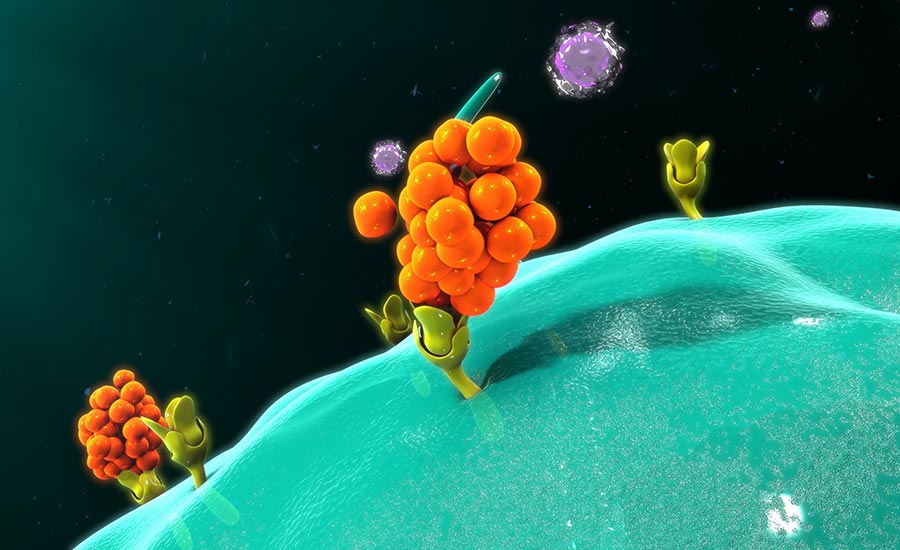Related Resources
Your body has a special system called the immune system that helps protect you from viruses and other types of invaders. Think of it like an army that fights off bad intruders that try to make you sick!
Your immune system is made up of different types of cells that work together to find and destroy germs.
Macrophages are like combat tanks that patrol your body, mercilessly devouring the enemies that come their way.
In one of our previous posts, we talked about macrophages and what they are. This time around, we’ll dive into how macrophages function and why these tiny cells are so important for your well-being!

What Are Macrophages?
Macrophages are a type of white blood cell that play a critical role in the immune system.
They are a part of your innate immune response, i.e., your body’s first-responders club. This means that, alongside neutrophils, macrophages are among the first to face the pathogens that attack you.
Macrophages perform many key functions in your body.
They are the BIOWARRIORS that eat up germs, viruses, dirt, dead cells and anything else that doesn’t belong inside your body. If there’s a risk that something might make you sick, macrophages get rid of it.
Think of these warriors as an army of Pac-Men. You know, the round yellow creatures with a big mouth that eat everything that gets in their way?
That’s how macrophages work in your body:
View this post on Instagram
If a particle means you harm, it better be prepared to face the wrath of macrophages!
Aside from identifying and destroying pathogens and foreign particles, macrophages also help develop your immune response. Once the macrophages devour the invaders, they present proteins of the dead cells to T-Cells; that way, the T-Cells can recognize and eliminate the invaders if they attack you again.
Where Are Macrophages Made?
Macrophages are made in the bone marrow — the gelatinous tissue inside your bones. Think of bone marrow as a factory that makes all the different helpers your body needs to stay healthy.
Macrophages develop from hematopoietic stem cells (HSCs). Once these cells are made in the bone marrow, they travel to other organs where they turn into other cells, including macrophages, but also red and white blood cells as well as platelets.
Once the macrophages are made, they begin their journey of roaming your body and protecting it.
In the BIOWARS comic book, which describes the everlasting battle between the immune system and invaders that wish to harm it, macrophages are personified as the fearless Phagien and Scathe.
Alongside other BIOWARRIORS, the brave duo fights hard to keep the BIOCOSMOS safe from the bad guys.

What Types Of Macrophages Exist?
There are two main types of macrophages:
- Resident macrophages
- Inflammatory macrophages
Before we start discussing functions of macrophages, it’s important to understand which types of these white blood cells exist and where they’re located.
1. Resident Macrophages
Resident macrophages are found in specific tissues and organs, such as the liver, lungs and spleen. They stay in these locations permanently.
Resident macrophages come from monocytes — the white blood cells that grow in the bone marrow and differentiate into macrophages and dendritic cells (which play a key role in the adaptive immune response).
Resident macrophages are different from other types of macrophages, such as blood-borne monocytes or inflammatory macrophages that are recruited to sites of infection or injury.
2. Inflammatory Macrophages
Inflammatory macrophages represent the warriors that are produced in response to an infection or injury.
They are monocytes that enter infected areas and transform into macrophages.
Inflammatory macrophages are among the key players of your immune system, because not only do they destroy invaders and cellular debris, but they also send signals to other immune system cells, such as neutrophils, Natural Killer Cells, T-Cells and B-Cells. Once the other warriors register that signal, they rush to the site where the injury or infection occurred, to launch an attack on pathogens.
Depending on their function and phenotype (observable characteristics), inflammatory macrophages can be divided into two sub-types:
- M1 macrophages
- M2 macrophages
M1 is a subset of inflammatory macrophages that represents classically activated macrophages. These guys are like superheroes that fight hard to keep the germs off, prevent them from harming you and clean up their mess.
M2 inflammatory macrophages are like tiny builders. They’re often called regulatory macrophages. These cells help resolve the inflammation as well as fix and rebuild everything that suffered damage while battling invaders.
M1 and M2 macrophages work together to keep you healthy and make sure you recover when you’re not feeling well.
Now, let’s explore the functions of macrophages in more detail!

How can a virus make you sick? Click to find out!
What Are The Main Functions Of Macrophages?
Macrophages have many key functions in the immune system, including:
- Phagocytosis: This is the process during which macrophages engulf and ingest pathogens and debris as well as foreign particles. Phagocytosis protects you from infections and diseases and promotes tissue repair by removing dead and/or damaged cells.
- Pathogen destruction: Aside from destroying pathogens during phagocytosis, macrophages can also release toxic molecules called reactive oxygen species (ROS) and reactive nitrogen species (RNS) to kill the enemies.
- Inflammation: Macrophages release chemical signals — cytokines — which help notify other immune cells about the presence of invaders. Cytokines also allow macrophages to promote inflammation. The rest of the immune system cells then rush to the site of an infection or injury to do their job and take down the enemy.
- Presentation of antigens: Macrophages can present antigens, which are proteins found on the surface of bacteria, viruses, and other microorganisms, as well as on the surface of cancer cells and other abnormal cells in the body. Macrophages can display antigens on their surface, which can help other immune cells recognize and target pathogens.
- Immune response regulation: Macrophages have an important function in regulating your body’s immune response. They do this by releasing molecules that can inhibit or promote inflammation, but also by getting rid of the immune cells that are no longer needed.
- Tissue repair: Macrophages participate in tissue repair by removing dead cells and debris and by promoting the formation of new blood vessels and connective tissue.
- Detoxification: Macrophages can help detoxify some organs, like the liver and the lungs, by breaking down and eliminating harmful substances.

Specialized Macrophages & Their Functions
Aside from having a critical role in protecting your body from diseases, macrophages also perform some additional functions that affect your well-being.
These tasks are carried out by specialized macrophages, which include:
- Kupffer cells: These cells are specialized macrophages that live in your liver. They are responsible for removing bacteria, viruses, and other foreign particles that enter the body through the bloodstream, as well as for breaking down and removing dead cells and cellular debris. Like other types of macrophages, Kupffer cells also play a role in immune response, by producing cytokines and activating other immune cells. These cells also promote tissue repair and the healing process in the liver.
- Alveolar macrophages: These macrophages reside in the alveoli — the tiny sacs in the lungs where the exchange of oxygen and carbon dioxide takes place. Alveolar macrophages ensure that the lungs remain free from invaders. They keep the lung sacs open and clear, ensuring gas exchange.
- Microglia: These macrophages reside in the brain and spinal cord, i.e., your central nervous system (CNS). Microglia are the primary immune cells of the CNS and are responsible for surveying and maintaining the health of the brain and spinal cord 24/7. They remove cellular debris, and they play a key role in repairing damaged nerve cells and in the formation of new nerve connections. Microglia also participate in removing harmful protein that is associated with Alzheimer’s disease.
- Osteoclasts: These specialized macrophages release acids and enzymes that break down and remove bone tissue. This process is called bone resorption. The activity of osteoclasts is balanced out by osteoblasts, which run the activity of bone formation. Osteoclasts and osteoblasts help maintain healthy bones and repair damaged bones. Osteoclasts are also involved in the regulation of calcium and phosphate levels in the blood.
- Cardiac-resident macrophages: Macrophages are also present in the heart — including in the heart muscle, the blood vessels and the surrounding tissue. These macrophages affect the immune response and inflammation in the heart, which can affect the electrical activity of this organ.

A Recap On The Functions Of Macrophages
Macrophages perform many crucial functions in your body.
They are the indispensable warriors of your immune system that protect you from infections, diseases and injuries.
Macrophages are key players that have the power to identify and destroy the enemy as well as remove dead cells.
The functions of macrophages are particularly important during the process of inflammation. Not only do they fight the invaders on their own, but they also display antigens on their surface, which allows them to recruit more warriors of the immune system to the battlefield and develop your adaptive immune response.
Moreover, macrophages promote tissue repair and are crucial for keeping your bones and many organs healthy, including the lungs, liver and heart. These little cells work hard to keep your organs free from bacteria and other harmful particles that don’t belong there, maintaining your overall health.








